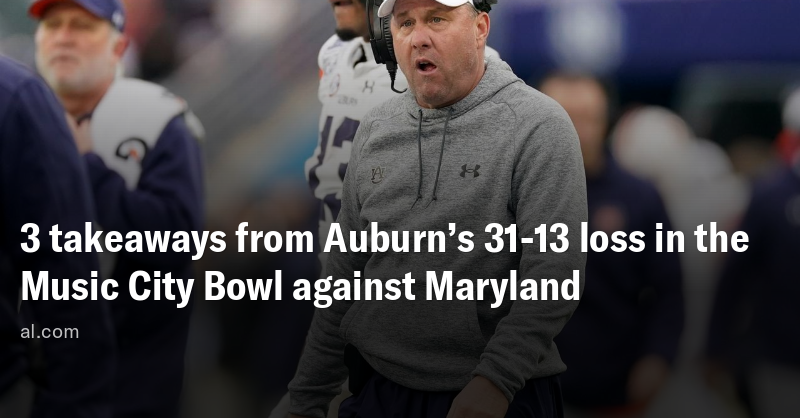By Matt Cohen
Auburn, now 6-7, clinched a third straight losing season on Saturday as it lost the Music City Bowl 31-13 to Maryland (8-5) at Nissan Stadium in Nashville, Tennessee.
It has been more than 45 years since Auburn had three consecutive losing seasons. It has not won a bowl game since the 2018 Music City Bowl in this same stadium. Head coach Hugh Freeze is now 6-3 in bowl games.
It was a day defined arguably more by those who were not on the field by those on it. Auburn leaves Nashville with a step forward by reaching a bowl season in Freeze’s first season, but with much to consider as its re-tooling the roster looking toward 2024.
Here are three takeaways from Auburn’s disappointing return to postseason play.
Auburn can’t recover from a horrid start
This felt like the reverse of one of Auburn’s games earlier this season: the 48-10 win in early November against Arkansas. Auburn jumped out to a 21-point lead in the first quarter and cruised from there.
It was the exact opposite Saturday as Maryland took the same 21-0 lead in the first quarter.
Despite starting quarterback Taulia Tagovailoa opting out of the game as he prepares for the 2024 NFL Draft, the Terps shredded the Tigers’ defense. Maryland had 226 yards to Auburn’s 42 in the opening 15 minutes.
Maryland had 150 more passing yards than Auburn during the first quarter. Both Maryland backup quarterbacks — Billy Edwards Jr. and Cameron Edge — had no troubles with Auburn’s new-look secondary (more on that below).
The Terps scored touchdowns on each of their first three drives. All three drives traveled at least 75 yards.
There were several missed tackles and blown coverages. It was certainly evident of a group of new faces who had not played in their new roles or together much.
That hole coupled with an Auburn offense which further showed exactly why Freeze pursued so many top-end high school receivers was too much to recover from.
Auburn never gave itself a chance to come back with four turnovers in the second half.
Auburn’s secondary was very thin. It proved to be a big deal.
Let’s talk about that secondary. So Auburn was without starting safety Jaylin Simpson for an unknown reason as well as starting cornerbacks Nehemiah Pritchett and DJ James. The talk all week centered on young defensive backs seeing extended playing time and concerns over inexperience as a result.
That showed up, especially in the first quarter.
Keionte Scott started as an outside cornerback for the first time at Auburn with freshman Kayin Lee across from him. Donovan Kaufman started in Scott’s normal nickel cornerback position. Caleb Wooden started at safety.
Safety Zion Puckett was the only regular in the secondary to start for Auburn.
As part of Maryland’s 158 first quarter passing yards, the group without any continuity or chemistry together looked like, well, exactly that.
The group struggled to make tackles and was frequently beaten by several receivers from a very talented Maryland corps.
The secondary was close to multiple interceptions but failed to make them. Young players like Champ Anthony, Colton Hood and Terrance Love all saw their most significant playing time in college. Flashes of their potential were shown — especially with a Hood near-interception in the second quarter — but Auburn finds itself grappling with questions in its secondary going into next year.
Outside of Scott and probably Lee, there will be several position battles among the secondary heading into next season. The depth behind Auburn’s four NFL-bound secondary pieces wasn’t ready just yet.
They played better as the game went on, especially in the second half. But by that point, with the result of the game largely in hand,
The Freeze Four (Or Five) can’t get here soon enough
This wasn’t a breakdown on any one player but just an overall bad day from an Auburn offense that has had several very bad days this season. This bad day was a further explanation and probably a defense of Freeze’s development strategy.
He made a bold claim when standing behind Payton Thorne as his quarterback for next season. Thorne struggled against Maryland completing only 13 of 27 passes for 84, one touchdown and one interception.
He did not help himself. He was benched in the fourth quarter after what would have been a second interception if not for it being wiped out by a penalty on Maryland.
But he did not receive much help either.
Auburn was so stretched at receiver with four entrants into the transfer portal. It meant several tight ends being lined up in wide receiver positions. It meant more targets to tight ends than any other position on the field.
And frankly, this was just an implication of why Auburn’s loaded high school wide receiver class — five-star recruits Cam Coleman and Perry Thompson as well as four-stars Malcolm Simmons and Bryce Cain — can’t get to campus fast enough. Cain is already with the team.
Auburn needs the influx of pass-catching talent. But it’s hard to think their addition alone will fix the problems within this offense.










